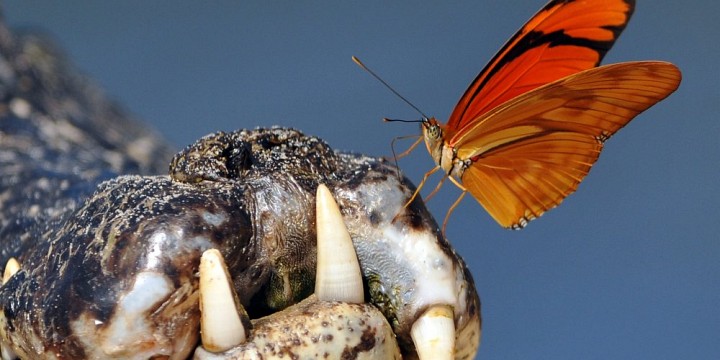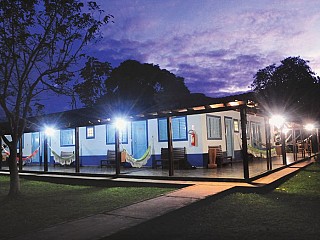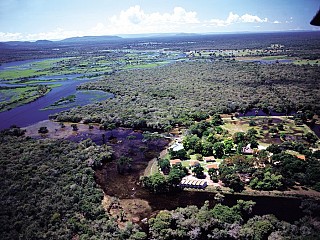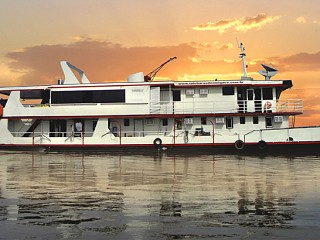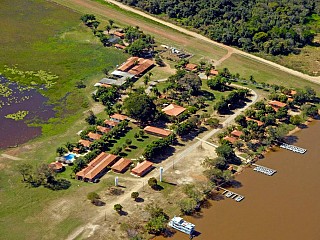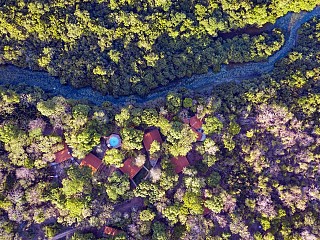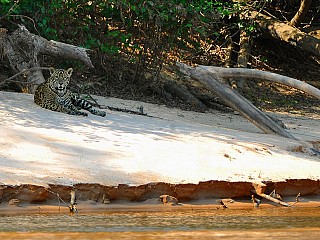The Pantanal is the largest wetland in the world with a total area of 150,000 km ². Most of the Pantanal is in Brazil, which covers the southern part of Mato Grosso and much of the northern region of Mato Grosso do Sul, but also extends into neighboring Bolivia and Paraguay.
The Pantanal is a paradise for wildlife viewing. Flood plains of the Pantanal are a nutrient- rich environment that support an abundance of wildlife , including tapirs , anacondas , capybaras , caiman , iguanas , anteaters , deer , turtles , raccoons , armadillos , otters , skunks, ocelots , pumas, monkeys and the rare and magnificent jaguar . Add this to an impressive amount of 670 species of birds that can be seen in the Pantanal, and you have the highest concentration of wildlife in the Americas.
Life in the Pantanal
In the drier months, the water flows slowly from north to south, leaving behind scattered pools that are a vital source of food for native animals and birds. These pools have high concentrations of fish, and many animals migrate to the north to have access to this food.
This changing habitat means that the water in the Pantanal is never stagnant, resulting in a fertile environment that has about 100 different mammals , 50 species of reptiles and 1,500 types of plants .
The richness of the Pantanal supports a great part of the wildlife of South America. The Pantanal is one of the best places to see giant otters, giant anteaters and armadillos.
Visiting the Pantanal
The Pantanal is divided into the northern Pantanal, covering 1/3 of the whole area, and the southern Pantanal, covering 2/3 of the area with the environment of wetlands is at its most intense. There are excellent accommodations where you can stay while visiting both areas and enjoy nature.
How to get to the Pantanal?
To get to the Pantanal in Brazil you need to fly to Cuiaba if you would like to visit the North of the Pantanal or fly to Campo Grande if you would like to visit the South Pantanal.
Tours to the Pantanal can combine very well with trips to Iguazu Falls and Bonito.
- Northern Pantanal
At a slightly higher elevation, the Northern Pantanal is slightly drier than the south, and possibly more accessible via the main city of Cuiabá.
Southwest of town is the city of Poconé and the beginning of the Transpantaneira Highway , the only road that crosses the region , which goes south and is about 145 km (90 miles ) long to Porto Joffre .
The Transpantaneira Highway is composed of about 100 wooden bridges, earning a place in the Guinness Book of Records as the highway with the highest number of bridges in the world. On each side of the road you will see large artificial trenches filled with water throughout the year. These pools provide a haven for wildlife during the dry season and therefore great opportunities for wildlife viewing throughout the year.
If you happen to travel through the Transpantaneira Highway between the months of October and January, you can be rewarded with a glimpse of the elusive jaguar.
- Southern Pantanal
When the complex series of river systems overflow at the beginning of the rainy season, large open plains of the southern Pantanal of Mato Grosso do Sul are swallowed by vast quantities of water . Flooding causes an explosion of aquatic vegetation which in turn swells the population of fish that abound with abundant food and cover.
During these months , it is easy to understand why the first Portuguese explorers mistook the region with an ocean at first glance, naming the Xaraés Sea. If traveling in the wettest months a generous supply of mosquito repellent is advisable.
The 260 species of fish that reveled in the deluge of the previous season are now left scrambling for space and flocks of birds take advantage of this banquet.
When You Should Visit Pantanal?
- Drought: from May to October. The best time to watch wildlife.
The concentration of different species this time of year is an absolute delight for birdwatchers and anyone with a passion for nature. Between August-September dry season reaches its peak and the arid landscape takes on a similar appearance to the African savannah, before the clouds and rain return again in October.
- Rain season: from December to February. The flood season, the beauty of water.
December to February, heavy rains give way to clearer skies and drier , warmer weather , making it an excellent time for photographers to visit the region . As temperatures rise in the water levels begin to decrease, in July, the pools of water have shrunk to mere ponds - called " ebb Castle " - surrounded by large expanses of grassland lush .
Birdwatching in the Pantanal
The Pantanal is the scene of one of the most diverse bird communities in the world. Even for non - birders, perhaps one of the most spectacular sights are the ' ninhais ' – communities where hundreds of different bird species meet occupying the trees.
The northern Pantanal is particularly special in that it is home to several bird species that can be found in the Amazon, as the Sunbittern , which cannot be found farther south .
The Pantanal is one of the best places in the world to see parrots in the wild. 15 species of the parrot family are present, including the hyacinth macaw endangered - nearly 1 meter long and bright cobalt blue.
Waterfowl of the Pantanal are also stupendous. Herons, storks and pink spoonbills can be found in huge flocks during the dry season . The magnificent Tuiuiú, with its distinctive red and black cap , is the largest of its kind in America, and is often referred to as the symbol of the Pantanal . The Pantanal is also home to 45 species of birds of prey.
Want to know more about the Pantanal? Then see the list of facts below:
- The largest snake the Pantanal is the yellow anaconda. It measures up to 4.5 meters and feeds on fish, birds and small mammals.
- Tuiuiú, bird symbol of the Pantanal, has over 2 meters wide with open wings.
- The caiman measures up to 2.5 meters in length, feeding mainly on fish.
- The largest fish in the Pantanal is jaú a giant catfish that reaches 1.5 meters in length, weighing up to 120 pounds .
- The annual flooding of the rivers in the region amounts to about 80 % of the Pantanal and transform the region into a stunning water table, removing part of the rural population to migrate temporarily to the cities or towns.
- The Pantanal receives about 700 thousand tourists per year, 65 % of whom are fishermen.
- The 210 square kilometers of the Pantanal are the sum of the areas of four European countries - Belgium, Switzerland, Portugal and Holland.
- The Pantanal jaguar can weigh 150 pounds, feeding approximately 85 species of animals that live in the region.
- The Brazilian Pantanal is 144 294 km2 of floodplain, of which 61.9 % (89,318 km²) in Mato Grosso do Sul, and 38.1 % (54,976 km²) in Mato Grosso.
- Every 24 hours, about 178 billion gallons of water entering the marsh plain.
- There are more species of birds in the Pantanal (656 species) than in North America (500) and more species of fish than in Europe (263 in the Pantanal versus about 200 in European rivers).










